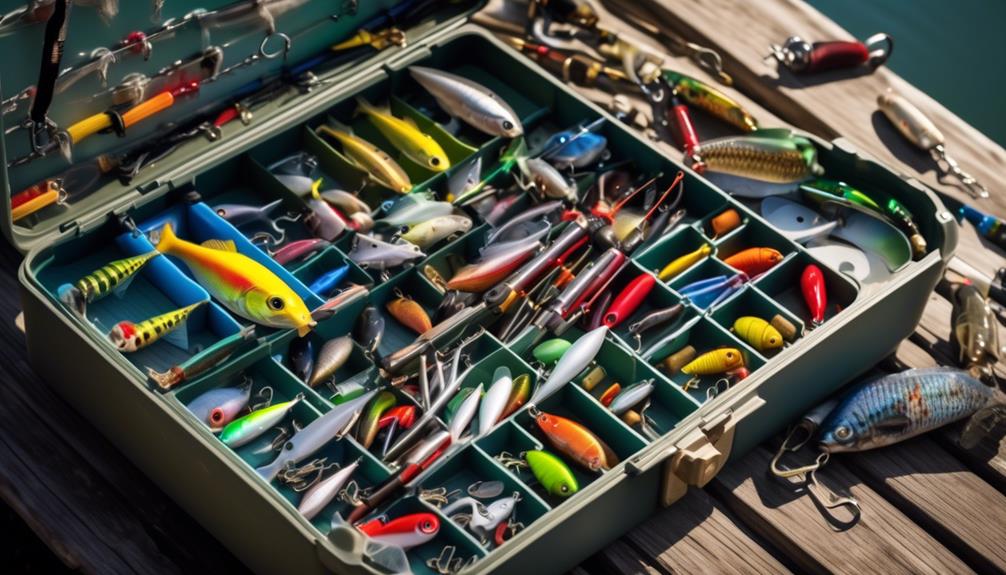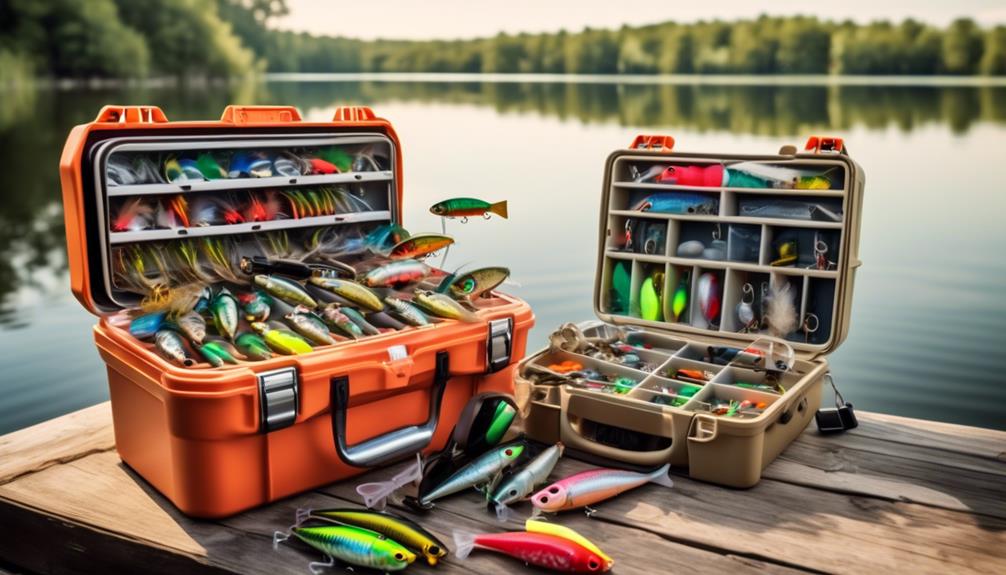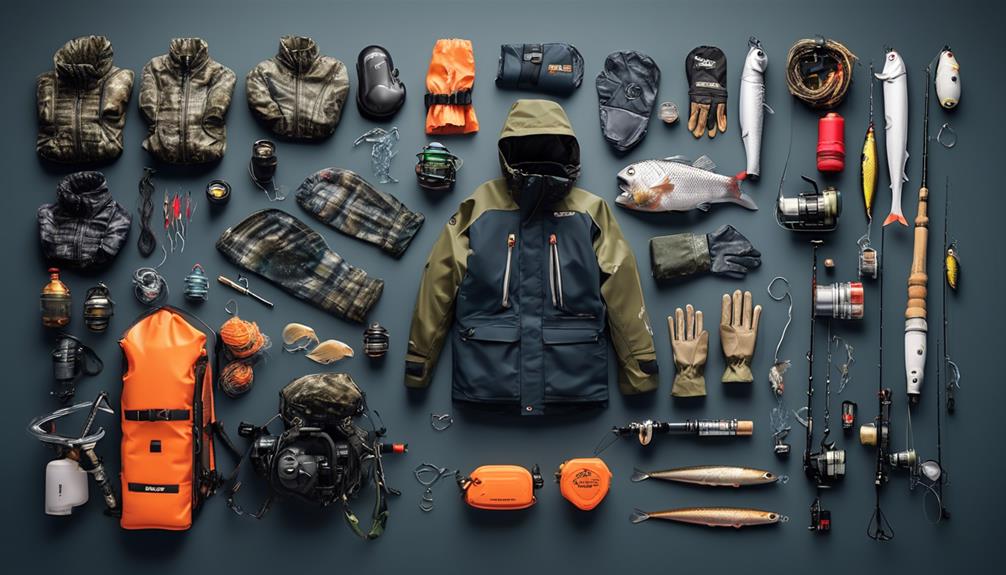When you're out on the lake, trying to reel in that elusive largemouth bass, having the right gear can make all the difference.
Take, for instance, the scenario of using a high-quality graphite fishing rod specifically designed for freshwater angling. The right rod can make casting more accurate and reeling in that trophy fish a smoother experience.
But what about the other essential gear that can elevate your freshwater fishing game? You might be surprised at how the right reel, line, hooks, and lures can significantly impact your angling success.
Rods
Selecting the right rod is crucial for freshwater fishing to ensure optimal performance and enjoyment. When it comes to rod maintenance, it's important to regularly clean your rod to prevent any dirt or debris from affecting its performance. Use a soft cloth and gentle detergent to wipe down the rod and guides, and always store it in a protective case when not in use.
As for rod materials, you'll find rods made from graphite, fiberglass, or a combination of both. Graphite rods are lightweight and sensitive, making them a popular choice for freshwater fishing, while fiberglass rods are more durable and flexible, suitable for handling larger fish or fishing in rougher conditions.
Rod action is another important consideration. This refers to how much the rod bends when pressure is applied. A fast action rod bends mostly in the top third or less of the blank, ideal for quick hook sets and fishing in open water. On the other hand, a slow action rod will bend starting at the base and is better suited for fishing in tight spaces or for targeting smaller fish.
When it comes to rod length, it's all about personal preference and the type of fishing you're doing. Shorter rods offer more accuracy and control, while longer rods provide greater casting distance and leverage when fighting fish. Consider the specific conditions you'll be fishing in to determine the most suitable rod length for your needs.
Reels
When choosing a reel for freshwater fishing, consider the type of fish you'll be targeting and the fishing techniques you'll be using. Reels come in various sizes and types, each suited for specific fishing needs. The right reel size is crucial for successful angling.
For smaller freshwater fish like trout or panfish, a lightweight reel in the 1000 to 3000 size range is ideal. If you're targeting larger species such as bass or pike, opt for a reel in the 3000 to 5000 size range. This ensures you have the appropriate line capacity and drag strength to handle these fish.
In addition to choosing the right reel size, proper maintenance is essential to ensure your reel functions smoothly and lasts a long time. Regular maintenance includes cleaning the reel after use, oiling the moving parts, and inspecting for any signs of wear or damage. This won't only extend the life of your reel but also ensure it performs optimally when you're out on the water.
When it comes to freshwater fishing, the reel is a critical piece of equipment. By selecting the right size and maintaining it properly, you can enhance your angling experience and increase your chances of landing that prized catch.
Lines
To maximize your freshwater fishing success, ensure you have the right type and strength of line for the specific fish species you're targeting and the fishing techniques you'll be employing.
When it comes to selecting the perfect fishing line, consider the following essential factors:
- Type of Line: Choose between monofilament, fluorocarbon, or braided lines. Monofilament lines are versatile and stretchable, making them suitable for beginners. Fluorocarbon lines are nearly invisible underwater, making them ideal for clear water conditions. Braided lines are incredibly strong and sensitive, suitable for heavy cover and deep water fishing.
- Line Strength: The strength of your line is crucial. Match the line's pound test to the size of the fish you're targeting. Heavier lines are suitable for larger fish, while lighter lines are ideal for smaller species.
- Knot Tying: Mastering different types of knots is essential for securing your bait or lure to the line and connecting the line to the reel. The improved clinch knot and palomar knot are popular and reliable choices for freshwater fishing.
- Casting Techniques: Your line choice can impact your casting distance and accuracy. Understand the characteristics of your line and practice different casting techniques to maximize your effectiveness on the water.
Hooks
Consider the size and type of hooks that best suit the fish you're targeting and the bait or lure you'll be using. Hook sizes range from as small as size 32 to as large as 19/0, with the smaller sizes suitable for panfish and trout, while the larger sizes are ideal for targeting bigger species such as pike or catfish. When it comes to materials, stainless steel hooks are durable and resist corrosion, making them suitable for freshwater angling. For certain applications, such as fly fishing, hooks made of lightweight materials like carbon steel or nickel might be preferred to maintain the natural buoyancy of the fly.
Setting the hook is a crucial skill in fishing. When you feel a fish bite, swiftly pull the rod tip up and to the side to set the hook firmly in the fish's mouth. Practice the motion to ensure a quick and efficient hook set, preventing the fish from spitting out the bait. Additionally, it's important to regularly sharpen hooks to maintain their piercing power. A sharp hook improves hook-setting performance and reduces the risk of losing a catch. Use a hook sharpening tool to maintain the sharpness of the hook points, ensuring they remain effective throughout your fishing trip.
Lures
You'll want to select lures that mimic the natural prey of the fish you're targeting, as this increases the likelihood of attracting bites. When choosing lures, consider the following factors to optimize your chances of a successful fishing trip:
- Lure color, effectiveness: Pay attention to the water's clarity. In clear water, opt for natural-looking lures that blend in with the surroundings. For murky water, brighter and more contrasting colors are effective. Additionally, consider the specific color preferences of the fish species you're targeting. For example, bass tend to be attracted to green and brown hues, while trout may respond better to silver or gold patterns.
- Lure size, fish preferences: The size of the lure should match the typical prey of the fish you're pursuing. Larger lures can attract bigger fish, while smaller lures are more suitable for species with smaller mouths. Take into account the specific feeding habits and preferences of the fish in your chosen fishing spot. For instance, if the fish in the area primarily feed on smaller insects or baitfish, using smaller lures that mimic these prey can yield better results.
Bait
When selecting bait for freshwater fishing, opt for options that are attractive to the specific fish species you're targeting and are suited to the prevailing water conditions. Live bait, such as minnows, worms, and insects, can be highly effective for enticing a wide range of freshwater fish. The natural movement and scent of live bait make it appealing to predatory fish like bass, walleye, and trout.
On the other hand, artificial bait, including soft plastic lures, hard baits, and spinners, offers versatility and durability. Artificial bait can mimic the appearance and movement of various prey, making it a valuable option for enticing fish in different conditions.
Bait presentation is crucial for success in freshwater fishing. When using live bait, ensure that it appears lively and natural in the water. For instance, hooking a minnow through the lips allows it to swim freely and attract more attention from fish. When selecting artificial bait, consider the color and size that best matches the natural prey in the water. Additionally, pay attention to the retrieval speed and depth at which the bait is presented, as this can greatly impact its effectiveness.
Experiment with different bait presentations to find the most successful approach for the specific fish species and conditions you're facing.
Tackle Boxes

To keep your angling gear organized and readily accessible, a quality tackle box is essential for freshwater fishing excursions. When selecting a tackle box, consider the type of fishing you plan to do and the amount of gear you need to carry. Here are some tips for organizing your tackle box and a few waterproof options to keep your gear safe and dry:
- Organization Tips: Utilize adjustable dividers to customize the layout of your tackle box. Sort your lures, hooks, weights, and other tackle by type and size, making it easier to find what you need during your fishing trip. Keep frequently used items in easily accessible compartments and reserve deeper sections for less commonly used gear.
- Waterproof Options: Look for tackle boxes specifically designed to be waterproof or invest in a waterproof tackle box bag or case. These options provide an extra layer of protection against water damage, ensuring your gear stays dry even in wet conditions. Additionally, consider adding silica gel packs to your tackle box to absorb moisture and prevent rust on hooks and other metal items.
- Easy Access: Choose a tackle box with secure latches and hinges that are easy to open and close, even when your hands are wet or you're wearing gloves. This will help you quickly access your gear without struggling with stubborn closures.
- Durability: Opt for a tackle box made from sturdy, impact-resistant materials that can withstand the rigors of outdoor use. A durable tackle box will protect your gear and endure frequent transport to and from your favorite fishing spots.
Fishing Accessories
Consider essential fishing accessories like pliers, line clippers, and a fishing scale to enhance your angling experience and ensure you're fully equipped for your freshwater fishing outings.
In addition to these basics, there are other accessories that can greatly improve your fishing trips.
Fishing nets are indispensable for landing your catch. Look for nets with rubber-coated mesh to protect the fish's scales and minimize damage.
Waders are another crucial accessory, particularly if you enjoy fly fishing or need to wade into the water to reach the best spots. Invest in durable, breathable waders that provide both comfort and protection from the elements.
Electronic fish finders can be game-changers, especially for locating fish in vast or unfamiliar waters. These devices use sonar to detect fish, underwater structures, and depth, guiding you to the most promising fishing spots.
Tackle organizers are key for keeping your gear tidy and easily accessible. Opt for a tackle bag or box with multiple compartments and adjustable dividers to accommodate different types of lures, hooks, and weights.
When selecting fishing accessories, prioritize quality and functionality. Ensure that your pliers are rust-resistant and have a built-in line cutter. Choose a fishing scale with a reliable weight capacity and easy-to-read display.
With the right accessories, you'll be well-prepared for a successful and enjoyable freshwater fishing experience.
Frequently Asked Questions
How Can I Properly Maintain My Fishing Gear to Ensure It Lasts for Many Seasons?
To ensure your fishing gear lasts for many seasons, proper maintenance is key. Regularly clean and inspect your equipment for any damage. Store it in a dry, cool place, and lubricate moving parts to prevent rust.
What Are the Best Techniques for Casting and Retrieving Lures in Freshwater Fishing?
To improve your freshwater fishing skills, focus on mastering casting techniques for accuracy and distance. When retrieving lures, use a steady, rhythmic motion to mimic natural prey. Vary your retrieval speed to entice different fish species.
Can You Provide Tips for Finding the Best Spots to Fish in a Freshwater Lake or River?
First, when locating fish populations, look for areas with structure like fallen trees or underwater ledges. Fish tend to gather there. Also, pay attention to water temperature and depth for finding hotspots.
Are There Any Specific Regulations or Restrictions I Need to Be Aware of When Freshwater Fishing in Different Locations?
Before you go freshwater fishing in different locations, make sure to research local regulations and restrictions. This is crucial for conservation and sustainability, as it helps minimize the environmental impact of your angling activities.
What Are Some Essential Safety Tips for Freshwater Fishing, Especially When It Comes to Handling Fish and Navigating the Water?
When handling fish, be gentle and use wet hands. Always wear a life jacket and be aware of your surroundings when navigating the water. Practice catch and release and follow fishing ethics for a sustainable experience.
Conclusion
Now that you've got the right gear, it's time to hit the water and reel in some big catches. Remember to stay patient, keep an eye on your surroundings, and enjoy the peacefulness of freshwater fishing.
With the top picks for angling gear, you'll be well-prepared for a successful and enjoyable fishing trip.
So grab your gear, head to your favorite fishing spot, and let the adventure begin!



